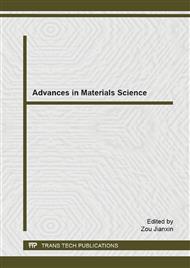[1]
Jin Y, Wang J, Ke H, et al, Graphene oxide modified PLA microcapsules containing gold nanomicrocapsules for ultrasonic/CT bimodal imaging guided photothermal tumor therapy, Biomaterials, 20 (2013) 4794-4802.
DOI: 10.1016/j.biomaterials.2013.03.027
Google Scholar
[2]
Zhang S F, Chen P H, Zhang F, Preparation and Physicochemical Characteristics of Polylactide Microspheres of Emamectin Benzoate by Modified Solvent Evaporation/Extraction Method, Journal of agricultural and food chemistry, 50 (2013) 12219-12225.
DOI: 10.1021/jf403722q
Google Scholar
[3]
Martins I M, Rodrigues S N, Barreiro M F, Release of thyme oil from polylactide microcapsules, Industrial & Engineering Chemistry Research, 24 (2011) 13752-13761.
DOI: 10.1021/ie200791r
Google Scholar
[4]
Shlomo Magdassi, David Avnir, Jerusalem, U.S. 6, 303, 149 B1. (2001).
Google Scholar
[5]
Hussain M, Atoms in agriculture: Nuclear techniques in" controlled-release" pesticide research, IAEA Bulletin, 2 (1989) 36-40.
Google Scholar
[6]
Brown E N, Kessler M R, Sottos N R, In situ poly (urea-formaldehyde) microencapsulation of dicyclopentadiene, Journal of Microencapsulation, 6 (2003) 719-730.
DOI: 10.1080/0265204031000154160
Google Scholar
[7]
R. Yan, Y. Zhang, X. Wang, Synthesis of porous poly(styrene-co-acrylic acid) microspheres through one-step soap-free emulsion polymerization: Whys and wherefores, Journal of Colloid and Interface Science, 1 (2012) 220-225.
DOI: 10.1016/j.jcis.2011.11.016
Google Scholar
[8]
Tsuda N, Ohtsubo T, Fuji M, Preparation of self-bursting microcapsules by interfacial polymerization, Advanced Powder Technology, 6 (2012) 724-730.
DOI: 10.1016/j.apt.2011.09.005
Google Scholar
[9]
Lobo F A, de Aguirre C L, Silva M S, Poly (hydroxybutyrate-co-hydroxyvalerate) microspheres loaded with atrazine herbicide: screening of conditions for preparation, physico-chemical characterization, and in vitro release studies, Polymer bulletin, 3 (2011).
DOI: 10.1007/s00289-011-0447-6
Google Scholar
[10]
Devi N, Maji T K, Genipin crosslinked microcapsules of gelatin A and κ-carrageenan polyelectrolyte complex for encapsulation of Neem (Azadirachta Indica A. Juss. ) seed oil, Polymer bulletin, 4(2010) 347-362.
DOI: 10.1007/s00289-010-0246-5
Google Scholar
[11]
Witschi C, Doelker E, Influence of the microencapsulation method and peptide loading on poly (lactic acid) and poly (lactic-co-glycolic acid) degradation during in vitro testing, Journal of controlled release, 2 (1998) 327-341.
DOI: 10.1016/s0168-3659(97)00188-0
Google Scholar
[12]
He G, Ma L L, Pan J, ABA and BAB type triblock copolymers of PEG and PLA: a comparative study of drug release properties and stealth, particle characteristics, International journal of pharmaceutics, 1(2007) 48-55.
DOI: 10.1016/j.ijpharm.2006.10.020
Google Scholar
[13]
Panyam J, Labhasetwar V, Biodegradable nanomicrocapsules for drug and gene delivery to cells and tissue, Advanced drug delivery reviews, 3 (2003) 329-347. 0.
DOI: 10.1016/s0169-409x(02)00228-4
Google Scholar
[14]
Venkatraman, Subbu S., Micelle-like nanomicrocapsules of PLA-PEG-PLA triblock copolymer as chemotherapeutic carrier, International journal of pharmaceutics, 1 (2005) 219-232.
DOI: 10.1016/j.ijpharm.2005.03.023
Google Scholar
[15]
Du Y J, Lemstra P J, Nijenhuis A J, ABA type copolymers of lactide with poly (ethylene glycol). Kinetic, mechanistic, and model studies, Macromolecules, 7 (1995) 2124-2132.
DOI: 10.1021/ma00111a004
Google Scholar
[16]
Asadi H, Rostamizadeh K, Salari D, Preparation and characterization of tri-block poly (lactide)-poly (ethylene glycol)-poly (lactide) nanogels for controlled release of naltrexone, International journal of pharmaceutics, 1 (2011) 356-364.
DOI: 10.1016/j.ijpharm.2011.06.035
Google Scholar


